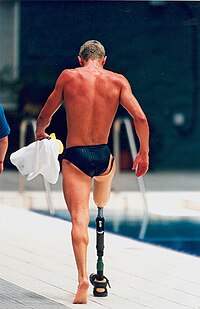
Photo from wikipedia
Background: Local health care facilities are often unequipped to treat complex upper extremity injuries, and patients are therefore transferred to designated trauma centers. This study describes the characteristics of patients… Click to show full abstract
Background: Local health care facilities are often unequipped to treat complex upper extremity injuries, and patients are therefore transferred to designated trauma centers. This study describes the characteristics of patients transferred to a Level I trauma center for hand and upper extremity injuries and to investigate the accuracy of the provided diagnosis at the time of referral. Methods: Adult patients transferred from outside facilities to the authors’ Level I trauma center by means of direct contract with the on-call fellow for the care of hand and upper extremity injuries were identified. Patient- and injury-related information was prospectively collected at the time of referral before patient transfer, and again following diagnostic evaluation by a hand surgeon at the authors’ institution. Results: Sixty-three patients were transferred to the authors’ hand surgery service from outside facilities after direct contact with the on-call fellow. Most patients were referred by emergency medicine physicians [n = 47 (76 percent)], followed by midlevel emergency department providers (physician assistant or nurse practitioner) [n = 12 (19 percent)] or hand surgeons [n = 3 (5 percent)]. Six patients were transferred directly from a Level I trauma center. Twenty-one transferred patients (33 percent) had an inaccurate diagnosis at the time of referral. Factors associated with an inaccurate diagnosis included trauma level of the referring hospital and diagnoses of infection or dysvascularity. Conclusions: The diagnostic accuracy for hand injuries transferred from outside facilities by means of provider-to-provider communication is imperfect, and some injuries are misdiagnosed. Hand surgeons should continue to improve the triage and transfer process for patients with acute hand surgery injuries. CLINICAL QUESTION/LEVEL OF EVIDENCE: Diagnostic, IV.
Journal Title: Plastic and Reconstructive Surgery
Year Published: 2020
Link to full text (if available)
Share on Social Media: Sign Up to like & get
recommendations!